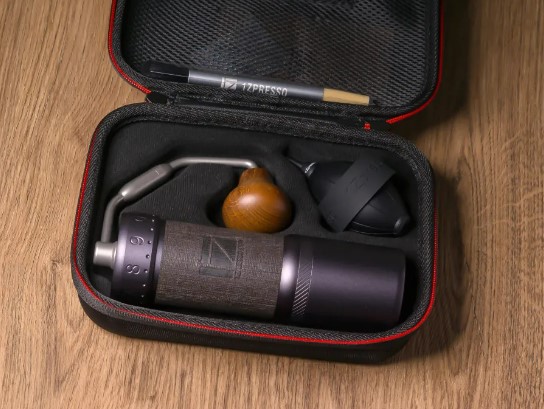Grind with Confidence: Experience the 1Zpresso J-Max Coffee Mill
Grind with Confidence: Experience the 1Zpresso J-Max Coffee Mill
Blog Article
Master the Art of Grinding Coffee Beans: A Guide to Coffee Grinders
For coffee lovers, the process of grinding coffee beans is more than simply a routine job; it is an art form that can substantially influence the taste and quality of the last mixture. Understanding the subtleties of different mill types, picking the suitable work dimension, and utilizing the right techniques are essential steps in the direction of achieving that excellent cup of coffee.
Kinds of Coffee Grinders
There are 3 main types of coffee mills generally made use of by coffee fanatics: blade grinders, burr mills, and manual mills. Blade grinders are the many basic kind, using a simple blade to slice the coffee beans. While they are affordable and simple to use, they often result in unequal coffee premises due to inconsistent grinding.
Manual mills, as the name suggests, call for hand-operated effort to grind the coffee beans. They are commonly liked by those who appreciate the process of hand developing coffee or for those who value transportability. Hands-on mills can differ in style, from straightforward handheld versions to more elaborate counter top versions. While they may call for more initiative, hands-on mills use control over the grinding process, allowing customers to readjust the work size to their preference. Each sort of coffee mill has its benefits and excellent usage cases, satisfying the diverse choices of coffee enthusiasts.

Choosing the Right Work Dimension
With an understanding of the various types of coffee grinders, the next essential step in accomplishing the excellent mug of coffee is choosing the right work size. The work dimension plays a significant role in identifying the taste account of your coffee (1Zpresso J-Max). Various developing techniques call for specific work dimensions to optimize the removal of flavors from the coffee grounds
For a coarse grind, ideal for French press and chilly brew approaches, the coffee beans need to look like breadcrumbs, giving a robust and bold flavor. Medium-coarse grinds, appropriate for Chemex or Clever Dripper, have a texture similar to crude sand, using a well balanced taste.
Medium grinds, typically utilized in drip coffee machine, have an uniformity looking like normal sand, resulting in an all-round taste. Great grinds, best for coffee makers, are akin to common salt, generating a rich and extreme preference. Extra-fine grinds, made use of in Turkish coffee, are as great as powdered sugar and create a strong and potent brew.
Grinding Strategies for Optimum Taste
To extract the max capacity of flavor from your coffee beans, understanding correct grinding methods is necessary. Consistency is essential when it pertains to grinding coffee beans for optimal taste. Making sure that the coffee beans are ground uniformly is critical to accomplish a balanced extraction throughout the brewing process. Among the essential methods for improving flavor is to readjust the grind size based on the developing technique being used. A fine grind is optimal for espresso machines, while a crude work is a lot more suitable for French press developing. Additionally, the Check This Out grinding time plays a substantial role in taste extraction. Over-grinding can cause a bitter preference, while under-grinding may result in a sour flavor. It is recommended to trying out different work dimensions and developing times to find the perfect balance that fits your taste preferences. By paying interest to these grinding techniques, you can raise the flavor profile of your coffee and enjoy an extra satisfying cup every time.
Upkeep and Cleaning Up Tips

Change any kind of damaged components immediately to maintain the quality of your coffee work. By complying with these maintenance and cleaning pointers, you can guarantee that your coffee mill continues to see this page supply tasty freshly ground coffee for years to come.
Troubleshooting Common Mill Issues


Ensuring your coffee mill functions smoothly requires skilled troubleshooting of typical problems that might develop throughout its usage. One typical trouble with coffee mills is irregular work dimension.
One more constant concern is grinder clogging. This can occur when oils from the coffee beans develop up and block the mill's chute. To settle this, dismantle the mill and tidy all parts completely, paying special attention to the chute and burrs. Furthermore, be mindful of overfilling the hopper to avoid blockages.
Finally, if your grinder is generating too much sound during procedure, it can suggest an Going Here issue with the motor or inner elements. In such instances, it is recommended to consult the supplier's directions for fixing steps or seek specialist support to identify and rectify the issue quickly.
Conclusion
Finally, understanding the art of grinding coffee beans entails comprehending the various kinds of coffee mills, choosing the right work size, using appropriate grinding techniques for ideal taste, and preserving and cleaning the mill routinely. By following these standards and troubleshooting common mill concerns, coffee fanatics can boost their coffee developing experience and enjoy a scrumptious mug of coffee every time.
Report this page